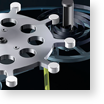
Basically, longitude is calculated by measuring time and observing astronomical phenomena. Galileo tried to solve this problem by observing the motion of Jupiter's satellites and applying a pendulum to a mechanical clock.
He determined the motion of the satellites using an instrument of his own invention, called the Jovilabe. A touch screen lets visitors use this instrument virtually.
The operation of the pendulum clock is illustrated by an enlarged reproduction of the timekeeper designed by Galileo and by a mechanical model that compares Galileo's circular pendulum with the cycloidal pendulum.
Very large models of escapements, which can be directly actuated, show how mechanical clocks operate.
Jovilabe (touch screen)
Museo Galileo - Multimedia Laboratory, 2012
Pendulum clock
Centro di Studi e Restauro per la valorizzazione di orologi antichi e strumentaria storico-scientifica - ITIS Leonardo da Vinci, Florence, 2009
Circular pendulum and cycloidal pendulum
Centro di Studi e Restauro per la valorizzazione di orologi antichi e strumentaria storico-scientifica - ITIS Leonardo da Vinci, Florence, 2011
Verge escapement with foliot regulator
Centro di Studi e Restauro per la valorizzazione di orologi antichi e strumentaria storico-scientifica - ITIS Leonardo da Vinci, Florence, 2011
Free anchor escapement
Centro di Studi e Restauro per la valorizzazione di orologi antichi e strumentaria storico-scientifica - ITIS Leonardo da Vinci, Florence, 2011
Cylinder escapement with flywheel regulator
Centro di Studi e Restauro per la valorizzazione di orologi antichi e strumentaria storico-scientifica - ITIS Leonardo da Vinci, Florence, 2011















